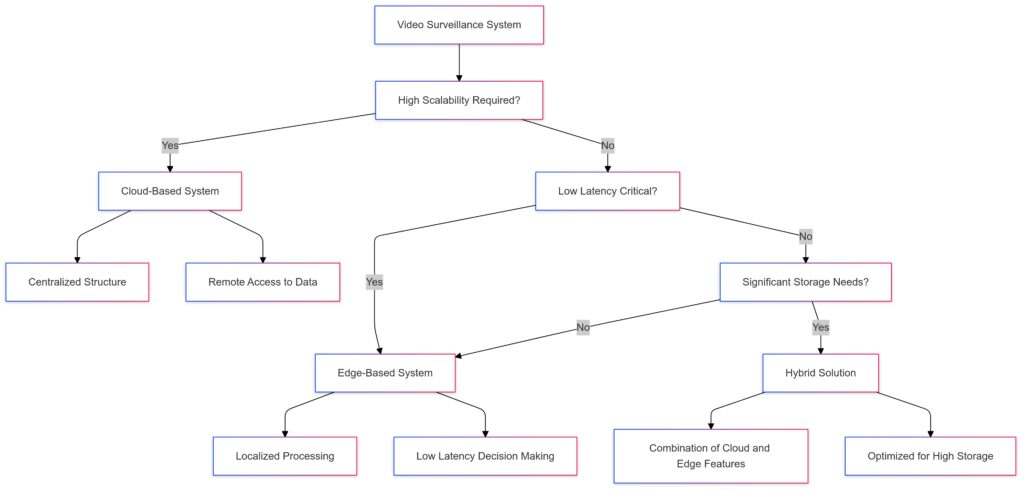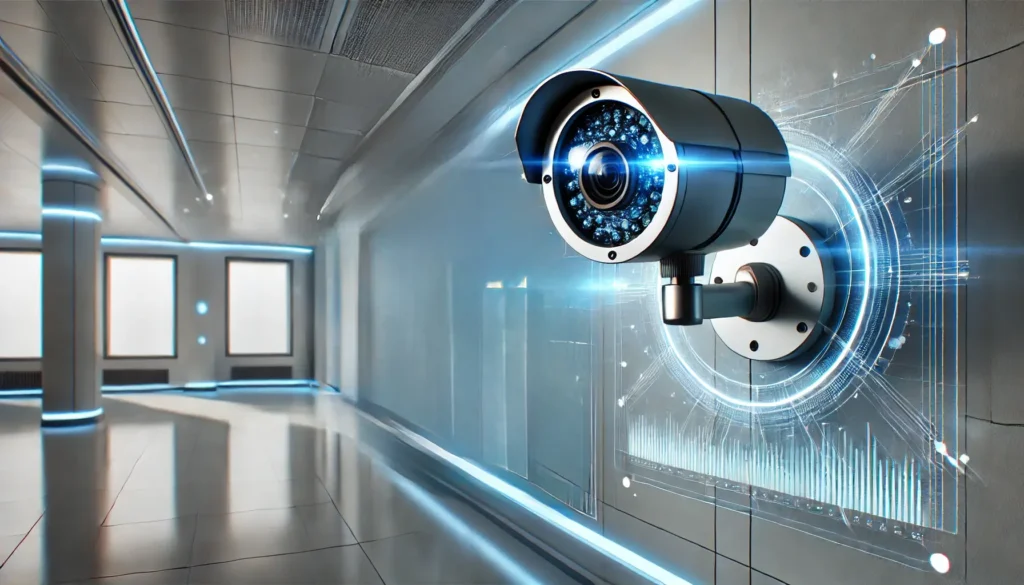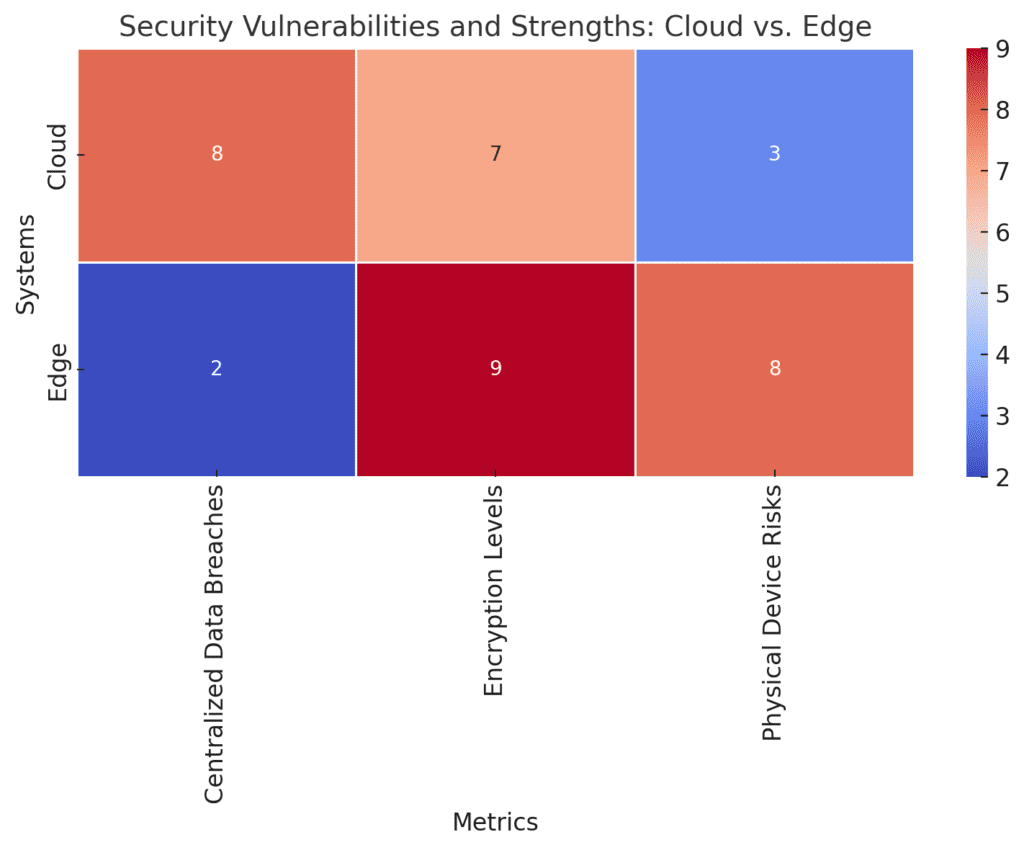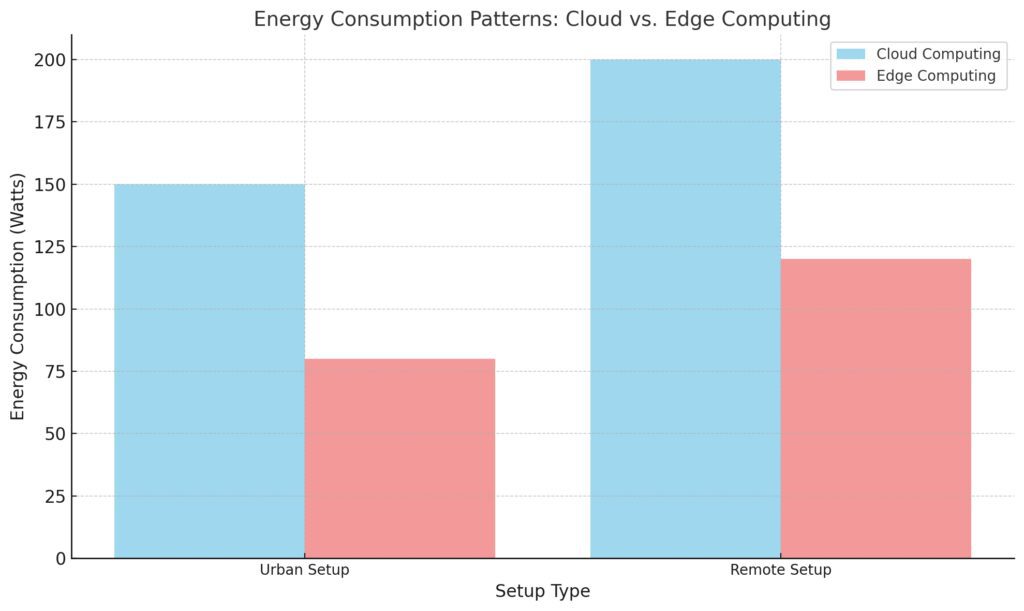
AI-powered video surveillance has reshaped the security landscape, offering smarter, faster, and more adaptive solutions. But when it comes to processing data, should you rely on cloud computing or embrace edge computing?
Each has its strengths, but your choice can significantly impact performance, costs, and scalability.
What Is Cloud Computing in AI Surveillance?
Centralized Data Processing
Cloud computing relies on centralized servers to handle data storage and analytics. Video streams from cameras are uploaded to remote data centers for processing. This model thrives on its scalability and access to robust computational power.
- Advantages:
- Unlimited scalability for large-scale surveillance projects.
- Easy to update AI algorithms remotely.
- Integration with other cloud services simplifies data sharing and analytics.
- Drawbacks:
- Latency issues due to data transmission.
- Higher reliance on stable internet connectivity.

Best Use Cases for Cloud in Video Surveillance
Cloud computing shines in multi-location security systems where massive data aggregation is key. It’s also great for scenarios requiring long-term video archiving and advanced AI models needing constant updates.
How Edge Computing Works in Surveillance
Processing at the Source
With edge computing, video analysis happens directly on the cameras or nearby devices. AI algorithms are embedded within the hardware, minimizing the need for data transfer to external servers.
- Advantages:
- Reduced latency for real-time decision-making.
- Lower bandwidth requirements—data stays local.
- Enhanced security by keeping sensitive data off external servers.
- Drawbacks:
- Limited computational power compared to cloud resources.
- Upgrading AI models can be cumbersome across multiple devices.
Ideal Scenarios for Edge Computing
Edge computing excels in real-time applications, such as facial recognition at entry points or detecting anomalies in crowded places. It’s a go-to for areas with unstable internet or where privacy concerns dominate.
Comparing Costs: Which Is More Budget-Friendly?
Cloud Costs Add Up
Cloud services often operate on a subscription-based pricing model, making them more expensive over time, especially for bandwidth-heavy surveillance systems.

Storage Expenses: Cloud solutions are more costly due to centralized storage needs.
Hardware Costs: Edge computing incurs higher hardware costs due to localized infrastructure.
Edge’s Initial Investment
Edge computing typically involves a higher upfront cost for specialized cameras and hardware. However, it eliminates ongoing data transfer and storage fees.
Scalability: Cloud or Edge?
The Cloud’s Unlimited Potential
Scaling with cloud systems is straightforward. You can add more cameras without worrying about local hardware capacity.
Edge’s Incremental Growth
Expanding edge systems means purchasing and deploying additional processing devices. While this offers control, it’s less seamless than the cloud.

Hybrid Solutions: The Best of Both Worlds?
Bridging Cloud and Edge
A hybrid approach combines cloud computing and edge computing to leverage the strengths of both. Initial video processing occurs at the edge, while deeper analytics and storage are handled in the cloud.
- Advantages:
- Real-time insights with edge processing.
- Advanced analytics using cloud resources.
- Flexible data storage options to suit specific needs.
Common Use Cases for Hybrid Models
Hybrid systems are popular in smart cities and critical infrastructure monitoring, where large-scale data analysis and immediate responses are equally important. These systems balance local processing demands with long-term data aggregation.

Cloud Servers handle:Large-Scale Analytics for comprehensive insights.
Centralized Storage for long-term data retention.
Data Flow:Processed data flows from edge devices to cloud servers.
Local analytics and centralized analytics/storage are distinct yet interconnected.
Security Implications: Cloud vs. Edge
Cloud’s Vulnerability
Cloud systems are a prime target for cyberattacks due to centralized data storage. Misconfigured servers or compromised credentials can lead to massive breaches.
Edge’s Localized Control
Edge computing enhances security by keeping sensitive data closer to its source. However, individual devices may be more vulnerable to physical tampering or localized malware attacks.
Balancing Security
A well-designed edge system with encrypted data and secure device management mitigates risks. For cloud setups, investing in robust cybersecurity protocols is essential.

Encryption Levels: Edge systems demonstrate stronger encryption adaptability.
Physical Device Risks: Edge systems are more prone to physical tampering due to their localized nature.
Real-World Examples
Cloud Computing in Action
Large retailers often rely on cloud-based video surveillance for their nationwide stores. AI-powered analytics track customer patterns, theft incidents, and operational inefficiencies while centralizing insights for top-level decision-makers.
Edge Computing Success Stories
Airports and stadiums use edge computing for real-time crowd management. AI algorithms detect anomalies like unattended bags or suspicious movements instantly, ensuring rapid responses in high-stakes environments.

Factors to Consider When Choosing
1. Bandwidth Availability
Cloud computing demands consistent, high-speed internet connections. In remote areas or locations with unreliable internet, edge computing is a better choice.
2. Data Sensitivity
If privacy laws or business policies limit data sharing, edge systems offer compliance by keeping data onsite.
3. System Scale
For expansive operations requiring centralized control, cloud solutions simplify management and updates. Smaller or decentralized setups may benefit more from edge computing’s localized power.
Cloud vs. Edge Computing in AI Video Surveillance: Comparison
| Feature | Cloud Computing | Edge Computing | Hybrid Systems |
|---|---|---|---|
| Data Processing | Centralized, on remote servers | Localized, at the device level | Split: initial processing at the edge, advanced analytics in the cloud |
| Latency | Higher due to data transfer to remote servers | Minimal as processing happens near the source | Balanced: real-time response locally, deeper insights via the cloud |
| Scalability | Highly scalable, easy to add new devices | Limited by device capacity | Moderately scalable with balanced resource use |
| Bandwidth Requirements | High for transferring continuous video streams | Low as only critical data is transmitted | Optimized by reducing unnecessary data transfers |
| Energy Efficiency | Higher due to always-on data centers and transmission | Lower as less data is transmitted and processed locally | Energy usage balanced between edge devices and the cloud |
| Security | Centralized storage poses higher breach risks | Localized storage enhances data privacy | Balanced: local security with centralized backup and encryption |
| Use Cases | Multi-location monitoring, long-term data analytics | Real-time responses, areas with poor connectivity | Critical environments needing real-time processing and long-term analytics |
| Costs | Subscription fees, long-term data storage costs | High initial investment for edge devices | Mixed: initial costs with reduced long-term expenses |
| AI Model Upgrades | Seamless, done centrally | May require manual updates on devices | Flexible: updates are centralized but applied selectively |
| Examples | Retail chains, urban surveillance | Wildlife reserves, autonomous vehicles | Smart cities, hospitals, logistics management |
Conclusion: Which One Wins?
The debate between cloud computing and edge computing in AI video surveillance doesn’t have a one-size-fits-all answer. The ideal choice depends on your specific needs—whether it’s speed, scalability, or security.
If you’re torn, consider a hybrid approach. It combines the best features of both systems, ensuring your AI video surveillance adapts to today’s dynamic security demands.
Still unsure? Dive deeper into your operational priorities and test solutions to find the perfect fit for your surveillance system!
FAQs
Is a hybrid system complicated to implement?
A hybrid system combines edge processing for immediate needs and cloud computing for long-term storage or complex analytics. While setup can be more intricate, it’s highly adaptable.
For example, a smart city project may use edge devices for instant traffic monitoring and rely on cloud analytics to plan infrastructure improvements. The initial investment pays off by providing both agility and scalability.
How does latency impact cloud-based surveillance systems?
Latency can significantly affect cloud-based systems, particularly in real-time surveillance scenarios. For example, in a busy retail store, a cloud-dependent system may delay recognizing a theft or customer incident due to the time needed to upload, process, and return actionable data.
This delay can hinder immediate responses. For critical use cases like emergency response or live monitoring, edge computing provides faster results by eliminating round-trip data transfer.
Can edge computing handle advanced AI models?
Edge computing is capable of running lightweight AI models, but more complex tasks often require cloud-level resources. For example, edge systems can detect motion, identify objects, or perform facial recognition. However, for deeper tasks, such as behavioral analysis or multi-camera tracking, cloud resources are typically needed due to their computational intensity.
Innovations in hardware like AI accelerators are bridging this gap, enabling more powerful AI processing directly at the edge.
How do hybrid systems manage storage?
Hybrid systems strike a balance between local and cloud storage. For example, a security setup at a hospital may store live footage locally for immediate access while sending periodic summaries or flagged events to the cloud for long-term storage.
This approach minimizes bandwidth usage while ensuring critical footage is backed up and accessible for audits or investigations.
Can cloud or edge systems adapt to future AI advancements?
Cloud systems are inherently more adaptable to AI updates because they don’t rely on hardware-specific capabilities. For instance, updating a cloud-based algorithm can be done centrally and applied across all devices instantly.
Edge systems, on the other hand, may require manual updates or hardware upgrades to support new AI features. However, newer edge devices are being designed with modularity and upgradeability, reducing this limitation.
Are there energy efficiency differences between cloud and edge systems?
Yes, energy consumption varies significantly. Cloud systems can be energy-intensive, particularly in large-scale operations, as they rely on always-on data transmission and power-hungry data centers. For example, streaming HD video to the cloud for analysis increases bandwidth and energy usage.
Edge systems, processing data locally, consume less energy because they avoid constant uploading. This makes them ideal for applications where power efficiency is a priority, such as in remote or eco-sensitive environments like solar-powered surveillance setups.

Remote Setup:Both systems exhibit higher energy use due to limited efficiency in remote conditions, with cloud computing still having the greater consumption.
How does scalability differ between cloud and edge systems?
Scalability is easier with cloud systems because new cameras or features can be integrated without upgrading physical infrastructure. For instance, a retailer expanding to new locations can simply add cameras that upload feeds to the same centralized cloud platform.
In contrast, edge systems require hardware upgrades or additional edge devices for each new location or feature. While this offers localized control, it’s less seamless than the cloud’s centralized expansion capabilities.
Which approach is better for compliance with privacy laws?
Edge computing typically aligns better with strict privacy regulations, as sensitive data can be processed locally without being transmitted to external servers. For instance, hospitals complying with HIPAA (Health Insurance Portability and Accountability Act) can use edge systems to analyze video feeds without uploading patient-related data to the cloud.
Cloud computing, while powerful, requires careful management of data residency and encryption protocols to comply with laws like GDPR or CCPA. A hybrid approach may also be a viable option, ensuring compliance while utilizing the cloud for non-sensitive tasks.
How do weather conditions affect cloud and edge systems?
Cloud systems depend on consistent internet connectivity, which can be disrupted by weather events like heavy storms. For example, a remote oil rig using cloud-based surveillance might experience interruptions if satellite internet is affected by severe conditions.
Edge systems, by processing data locally, are more resilient to weather-related disruptions, making them suitable for outdoor and remote environments where connectivity can be unpredictable.
Can cloud or edge computing reduce false alerts in surveillance?
Both cloud and edge systems can reduce false alerts, but their effectiveness depends on the use case. Edge systems excel at processing specific triggers, like motion detection or object recognition, to minimize unnecessary alerts. For example, a residential security camera using edge AI can differentiate between a stray cat and an intruder.
Cloud systems, on the other hand, analyze broader patterns by aggregating data from multiple sources. This can improve the accuracy of complex analyses, such as detecting coordinated activities across multiple locations, but may introduce a slight delay.
What industries rely on hybrid solutions for surveillance?
Industries like transportation and logistics frequently adopt hybrid systems. For example, a fleet of delivery trucks might use edge devices for onboard surveillance, detecting real-time risks like road hazards or driver fatigue. Meanwhile, cloud systems analyze aggregated data to optimize routes, monitor overall fleet safety, and store recordings for compliance.
Other industries like education also benefit, where edge systems manage on-campus safety while the cloud handles data retention and large-scale analytics.
Resources
Case Studies
- AWS and AI Surveillance for Smart Cities
Learn how Amazon Web Services powers cloud-based video surveillance in urban environments, focusing on scalability and analytics.
Read the case study - NVIDIA Jetson: Edge Computing in Action
NVIDIA highlights the use of edge AI in industries such as retail and public safety, showcasing real-world applications of edge-enabled cameras.
View the examples
Tools and Platforms
- Google Cloud Video Intelligence API
A tool for analyzing videos stored in the cloud, featuring object detection and activity recognition. Ideal for large-scale surveillance setups. - Azure Percept
Microsoft’s platform designed for edge AI solutions, including video surveillance and real-time analytics.
Learn about Azure Percept
Educational Content
- Coursera: Cloud Computing Specialization
A beginner-friendly course covering cloud architecture and applications, with modules relevant to video surveillance.
Start learning - LinkedIn Learning: Edge Computing Foundations
Offers foundational knowledge about edge computing, its advantages, and real-world use cases in video analytics.
Access the course
Forums and Communities
- r/SecurityTech on Reddit
A community discussing video surveillance technologies, including the latest in cloud and edge solutions.
Join the discussion - AI and Video Analytics Group on LinkedIn
Professionals in AI-powered surveillance share experiences, case studies, and the pros and cons of cloud and edge approaches.
Follow the group